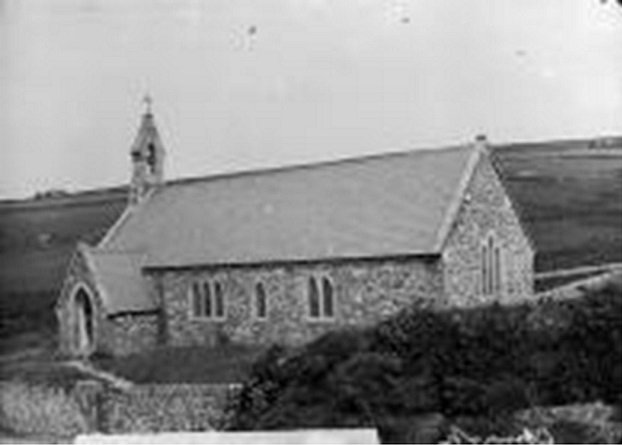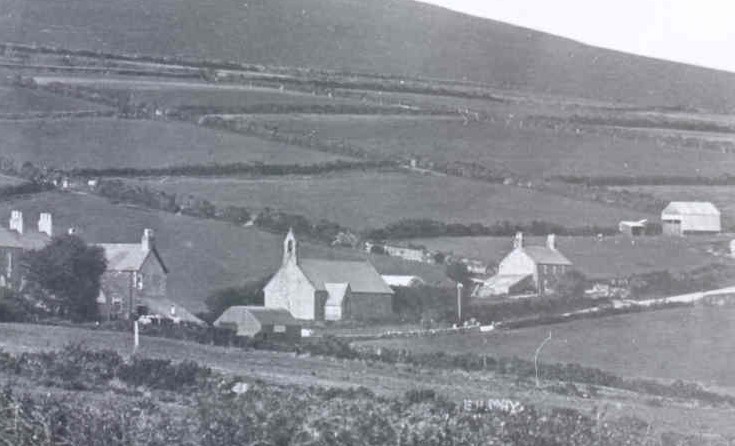The Church of
Saint James
The church was consecrated to Saint James. Prior to consecrating St James’ Church in 1882 to meet the need for a church in the village due to a change in population, church services were held in Llithfaen’s National School. The local boys used to go to church on a Sunday evening to listen to the Reverend Michael Jones, or Michaelions as he liked to be called, telling ghost stories. Sunday school in church was a hit in the 1950s because the children were given sweets!
 Close up of St. James’ church (Photo: John Thomas 1838-1905)
Close up of St. James’ church (Photo: John Thomas 1838-1905)
Carnguwch church was the original church of the parish. Some believed that Carnguwch was consecrated to Cuwch while others believe that Beuno was the patron saint for the parish. However, we know that the schools of Gruffudd Jones, Llanddowror were very successful in Carnguwch church at one stage.
A religious service was held in the national school in Llithfaen before the consecration of St. James’ church in 1882. In 1882 the school became the property of the County Council and the church was opened to meet the demands for a church due to change in the population. There were 112 persons recorded in the parish of Carnguwch in the census of 1901.
The boys used to go to the church on Sunday evenings to have ghost stories by Michaelions, the Reverend Michael Jones who liked to be called Michaelions. The Sunday school in the church were very popular during the fifties as sweets were shared to the children!
The Cambrian News and Meirionethshire Standard, 30 January 1880
LLITHFAEN.—A correspondent writes: It is seldom that the numerous readers of the Cambrian News meet with this name on the sides of their wide spreading paper. Llithfaen is a beautiful village situated about seven miles northward of the Cardigan Bay, and sixteen miles distance from Carnarvon. The place stands on the side of the Eifl mountains, in the parish of Pistyll. The locality is considered as one of the healthiest in Wales. The air is pure, and its springing waters exceedingly clear, good, and tasteful. During the last five years the place has greatly improved. There are not less than six granite quarries in the same parish, and all in full working order and promising well. During the summer season the place is visited by many persons from different parts of England and Wales. The view from the Eifl mountains is most interesting and delightful. On one of the summits the interesting remains Tre y Ceiri (Giants' town), well deserve a visit.
THE SCHOOL BOARD. The Committee of Council on Education gave notice some six years ago that a School Board should be formed at the place. The parishioners carried the order into operation, so we have a School Board but I regret to state that the results of the grants for the past years were not so satisfactory as we expected. But our School Board will undoubtedly manage to overcome the drawback of grants for the ensuing years. They have now bought a schoolroom (the church at the place) for their own use entirely, and intend to enlarge and improve it; also to build a house for the teacher, which will most likely cause less cnanga of teachers than in previous years. Therefore, we may expect better schooling and better grants in the future.
THE CHURCH.— Inasmuch as our church building is sold to the School Board, a new church is on the point of being erected. This is just the right thing in the right place. A new church is really wanted at Llitbfaeii, the old one being too small and inconvenient for the present congregation. The church is now very flourishing and blooming, through the energy and efforts of our new curate, Mr. Owen. I may add that Mr. Owen has but recently been appointed as the curate of this place. He was a student of St. Bees' College, Birmingham, and has passed all his examinations with credit, as well as the Cambridge Preliminary Examination. Though we have had as yet but little experience of Mr. Owen, yet we can conscientiously state that he is an earnest and faithful preacher. Mr. Owen is a native of Talybont, Ceredigion. EIFLIAN.

A picture of St James’ Church from the south side of the village.